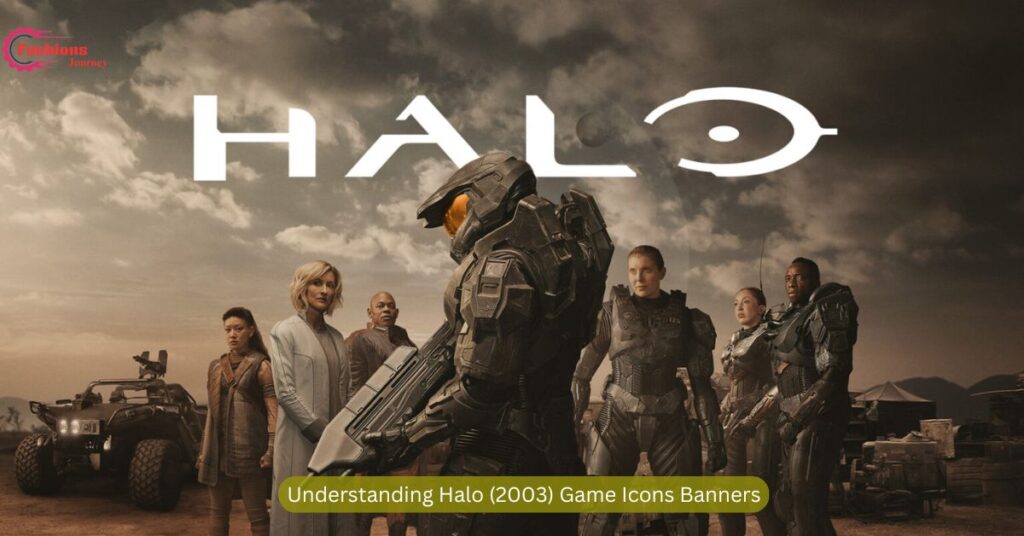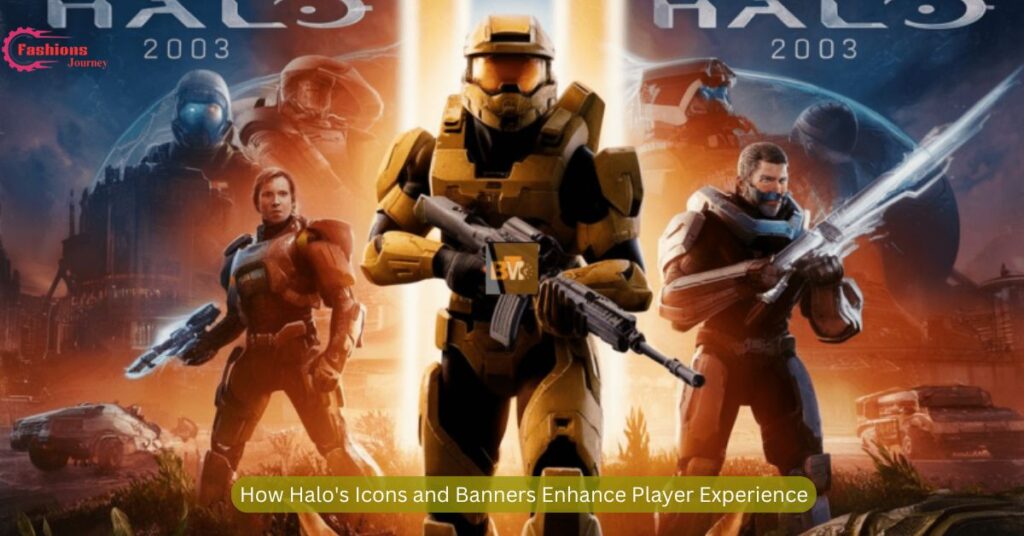Halo is a famous video game that came out in 2003. It has really cool pictures called icons and banners. These pictures help players understand the game better. The icons show things like weapons and characters. They are small but very easy to see. The banners are bigger pictures that show exciting parts of the game world. Both icons and banners use colors like blue and green a lot.
The people who made Halo were very smart about how they designed these pictures. They wanted them to look awesome and also be useful when playing the game. The main character’s helmet became a very famous symbol for Halo. Fans can spot it right away! These pictures didn’t just make the game look good. They also helped Halo become super popular and known by many people.
Understanding Halo (2003) Game Icons Banners

Game icons are crucial in video games. They serve as visual shortcuts. Halo’s icons are particularly memorable. The Master Chief’s helmet is a prime example. It’s simple yet powerful. The Halo ring is another iconic symbol. These icons represent the game’s essence. They are instantly recognizable to fans.
Banners play a different role. They set the tone for the game. Halo’s banners are epic in scale. They showcase the game’s sci-fi setting. The use of color is deliberate. Blue and green dominate the palette. This creates an alien feel. It’s both familiar and foreign.
The evolution of these visuals is fascinating. Early designs were simpler. They relied on bold shapes. As technology advanced, so did the icons. They became more detailed. The essence remained the same. This consistency is key to brand recognition.
Read This blog:What is Yeat Net worth? Bio, Wiki, Age, Height, Education, Career And More
What Are Game Icons?
Game icons are visual representations of in-game elements. In Halo (2003), these icons serve as crucial identifiers for weapons, items, and game modes. The iconic Master Chief helmet became one of the most recognizable game icons in gaming history. These small yet impactful graphics help players quickly understand and navigate the game’s interface.
Halo’s game icons are more than just functional elements. They are carefully crafted symbols that embody the game’s futuristic aesthetic. The designers used a combination of sleek lines and bold shapes to create icons that were both visually appealing and instantly recognizable. This attention to detail in icon design contributed significantly to Halo’s overall visual identity.
The use of color played a vital role in Halo’s icon design. The predominant blue hue associated with the game’s interface became a signature element. This color choice not only aligned with the game’s sci-fi theme but also ensured that icons stood out against various in-game backgrounds.
Evolution of Halo’s Iconography
Halo’s iconography has undergone significant evolution since its 2003 debut. The original game featured relatively simple icons, focusing on clarity and functionality. As the series progressed, the icons became more detailed and sophisticated, reflecting advancements in gaming technology and graphic design capabilities.
One notable aspect of this evolution was the increased use of depth and texture in icon design. While the original icons were largely flat and simple, later versions incorporated more 3D elements and intricate details. This shift added a new layer of visual interest to the icons while still maintaining their essential function.
The consistent use of certain core elements, such as the Spartan helmet and energy sword, helped to maintain a strong visual link between different games in the series. These recurring motifs became instantly recognizable symbols of the Halo franchise, transcending individual game titles.
The Art of Halo Game Banners

Halo’s game banners are works of art. They capture the game’s epic scale. Each banner tells a story. They showcase key characters and settings. The Master Chief often takes center stage. He’s usually in a heroic pose. The background hints at the game’s plot.
Color theory plays a big role in banner design. Halo uses a cool color palette. Blues and greens dominate. This creates a sense of mystery. It also reflects the game’s alien environments. Occasional pops of orange or red add drama. They draw the eye to important elements.
The composition of Halo banners is carefully planned. They often use the rule of thirds. This creates a balanced, pleasing image. Depth is also important. Foreground and background elements create a 3D effect. This adds to the sense of scale and drama.
Read This Blog:Was Chuck Connors Gay? Dispelling Rumors About the Actor’s Sexual Orientation
Significance of Game Banners
Game banners serve as visual ambassadors for video games. In the case of Halo (2003), these banners played a crucial role in establishing the game’s identity in the crowded gaming market. The banners were often the first point of contact between potential players and the game, making their design critically important.
Halo’s game banners were masterclasses in visual storytelling. They managed to convey the game’s epic scale, futuristic setting, and intense action through carefully composed images. The banners often featured the iconic Master Chief prominently, establishing him as the central figure of the Halo universe.
Halo’s banners also served to showcase the game’s unique environments. From the mysterious Halo rings to alien landscapes, these banners gave potential players a tantalizing glimpse of the diverse and intriguing worlds they would explore in the game.
Designing Memorable Halo Banners
The process of designing Halo’s memorable banners involved a careful balance of artistic vision and marketing strategy. The designers had to create images that were not only visually stunning but also effectively communicated the game’s key selling points.
One of the key strategies in designing Halo’s banners was the use of dynamic compositions. The banners often featured action-packed scenes or moments of high tension, creating a sense of excitement and urgency. This approach helped to convey the game’s fast-paced, action-oriented gameplay.
The designers also paid close attention to the use of scale in their banner designs. By juxtaposing the human-sized Master Chief against massive alien structures or sprawling landscapes, they were able to communicate the epic scope of the Halo universe.
Halo’s Iconic Visual Elements

Halo’s visual identity goes beyond icons and banners. The entire aesthetic is carefully crafted. The Mjolnir armor is a key element. It’s both functional and visually striking. The design has evolved over time. Yet, it remains instantly recognizable.
The Covenant aliens have their own unique look. Their designs are distinctly non-human. Yet, they’re not typical “little green men”. Each alien race has its own characteristics. This adds depth to the game world.
Weapon designs in Halo are iconic. The Assault Rifle is a fan favorite. Its shape is unmistakable. The Energy Sword is another standout. These weapons are more than just tools. They’re part of Halo’s visual language.
Key Components of Halo’s Visual Branding
Halo’s visual branding is built around several key components that have become instantly recognizable to gamers worldwide. The Master Chief’s armor, with its distinctive green color and golden visor, is perhaps the most iconic element. This design has remained largely consistent throughout the series, becoming a symbol of the franchise itself.
The Halo ring is another crucial component of the game’s visual identity. Its unique shape and massive scale have made it one of the most recognizable structures in gaming history. The ring serves as both a setting for the game and a powerful symbol of its sci-fi premise.
Iconography in Gaming: Halo’s Legacy
Halo’s approach to visual design has had a lasting impact on the gaming industry. The game’s success demonstrated the importance of strong, cohesive visual branding in creating a memorable gaming experience.
Many games that followed Halo adopted similar approaches to icon and banner design. The use of bold, easily recognizable symbols for in-game items and clear, dramatic imagery in promotional materials became more common in the wake of Halo’s success.
How Halo’s Icons and Banners Enhance Player Experience

Halo’s visual elements do more than look good. They enhance gameplay. Icons help players make split-second decisions. In the heat of battle, clear icons are crucial. They can mean the difference between victory and defeat.
Banners create atmosphere. They set player expectations. A well-designed banner builds excitement. It hints at the adventures to come. This emotional connection is valuable. It keeps players engaged even before they start playing.
Visual consistency aids player learning. Once you understand Halo’s visual language, it stays with you. This familiarity breeds comfort. Players can focus on gameplay, not deciphering new symbols.
Integrating Visual Elements into Gameplay
Halo’s icons and banners are not just decorative elements; they play a crucial role in enhancing gameplay. The game’s icons, for instance, allow players to quickly identify weapons, items, and objectives during fast-paced combat scenarios. This integration of visual design and gameplay mechanics contributes significantly to Halo’s smooth and intuitive user experience.
The consistent use of color coding across Halo’s visual elements helps players quickly process information. For example, blue is often associated with friendly units and objectives, while red signifies enemies. This color-based system extends from the game’s HUD to its promotional materials, creating a cohesive visual language.
Halo’s banners, while primarily used for marketing, also serve to set player expectations and build anticipation. By showcasing the game’s environments and action scenes, these banners prepare players for the type of experiences they’ll encounter in the game, enhancing their engagement and immersion.
Player Recognition and Recall
The distinctive visual style of Halo’s icons and banners plays a crucial role in player recognition and recall. The consistent use of certain visual elements across different games in the series helps players quickly acclimate to new titles, enhancing the overall user experience.
Halo’s iconic visuals also contribute to long-term brand loyalty. The strong associations players form with these visual elements can evoke positive memories and emotions long after they’ve finished playing the game. This emotional connection can drive continued engagement with the franchise.
The recognizability of Halo’s visual elements extends beyond the game itself. Merchandise featuring Halo’s iconic imagery, from t-shirts to posters, allows fans to express their connection to the game in their daily lives. This further reinforces the game’s visual brand and helps to maintain player engagement between game releases.
Creating Your Own Game Icons and Banners Inspired by Halo

Aspiring designers can learn from Halo’s success. Simplicity is key in icon design. Start with basic shapes. Refine them gradually. Remember, icons need to be recognizable at small sizes.
Color choice is crucial. Stick to a limited palette. This creates cohesion. It also makes your icons more memorable. Consider the emotions different colors evoke.
Consistency is important when creating a set of icons. Establish rules for your designs. Stick to them. This creates a unified look across your icon set.
For banners, focus on composition. Use the rule of thirds. Create depth with foreground and background elements. Pay attention to where the eye is drawn.
DIY Tips for Amateur Designers
Creating game icons and banners inspired by Halo can be an exciting project for amateur designers. Here are some tips to get started:
- Study Halo’s visual style: Pay close attention to the color schemes, shapes, and composition techniques used in Halo’s icons and banners.
- Start with simple shapes: Many of Halo’s icons are based on simple geometric forms. Begin your designs with basic shapes and refine from there.
- Use appropriate software: Tools like Adobe Photoshop or Illustrator are ideal for creating professional-looking icons and banners. However, free alternatives like GIMP or Inkscape can also produce great results.
- Consider scalability: Remember that icons need to be recognizable at various sizes. Ensure your designs remain clear when scaled down.
- Maintain consistency: If you’re creating multiple icons or banners, ensure they have a consistent style to create a cohesive look.
- Experiment with lighting: Halo’s visuals often feature dramatic lighting. Experiment with light and shadow to create depth and atmosphere in your designs.
- Incorporate sci-fi elements: Use futuristic shapes and textures to capture the essence of Halo’s sci-fi setting.
Legal and Ethical Considerations
While creating Halo-inspired designs can be a great way to develop your skills, it’s important to consider the legal and ethical implications:
- Respect copyright: Avoid directly copying Halo’s designs. Instead, use them as inspiration to create original work.
- Understand fair use: Familiarize yourself with fair use laws in your jurisdiction. These laws may allow limited use of copyrighted material for purposes such as commentary or education.
- Be transparent: If you share your work, clearly state that it’s Halo-inspired fan art and not official merchandise.
- Consider the purpose: Using your designs for personal projects or portfolios is generally acceptable. However, selling Halo-inspired designs without permission could lead to legal issues.
- Seek permission when necessary: If you plan to use your designs commercially, consider reaching out to the copyright holders for permission.
- Stay original: While drawing inspiration from Halo, strive to incorporate your own unique ideas and style into your designs.
- Respect the community: Remember that Halo has a dedicated fan base. Ensure your work respects the franchise and its community.
FAQs
What makes Halo’s icons and banners so iconic?
Halo’s icons and banners are iconic due to their distinctive design, consistent use of color, and strong association with the game’s themes. They effectively combine simplicity with futuristic elements, making them instantly recognizable.
How have Halo’s visual elements evolved over time?
Halo’s visual elements have evolved from relatively simple designs in the original game to more complex and detailed versions in later installments. This evolution reflects advancements in technology and the expanding Halo universe.
Can I use Halo-inspired designs in my own projects?
While you can create Halo-inspired designs for personal use or learning, using them commercially without permission could lead to legal issues. Always respect copyright laws and consider seeking permission for commercial use.
What tools are best for creating game icons and banners?
Professional tools like Adobe Photoshop and Illustrator are ideal for creating game icons and banners. However, free alternatives like GIMP and Inkscape can also produce great results for beginners.
How do Halo’s visual elements enhance gameplay?
Halo’s visual elements enhance gameplay by providing clear, intuitive information to players. They help in quick identification of items, enemies, and objectives, contributing to a smooth and immersive gaming experience.
Conclusion
The iconic status of Halo (2003) game icons and banners is a testament to the power of thoughtful, cohesive visual design in gaming. These elements have not only defined the aesthetic of one of gaming’s most beloved franchises but have also set industry standards for how games visually communicate with players.
From the instantly recognizable Master Chief helmet to the dramatic, action-packed banners, Halo’s visual elements have played a crucial role in building and maintaining the game’s massive fanbase. They have enhanced gameplay, facilitated player engagement, and contributed significantly to the game’s immersive sci-fi universe.
The evolution of these visual elements over time reflects both technological advancements and the expanding scope of the Halo universe. Despite these changes, the core visual identity established in the 2003 original has remained a constant, providing a strong foundation for the franchise’s continued success.

Liam Patel is a passionate fashion enthusiast with a keen eye for style trends.
With a background in textile design and years of experience in the fashion industry, Liam brings a unique perspective to his writing. He loves exploring sustainable fashion and street style.







